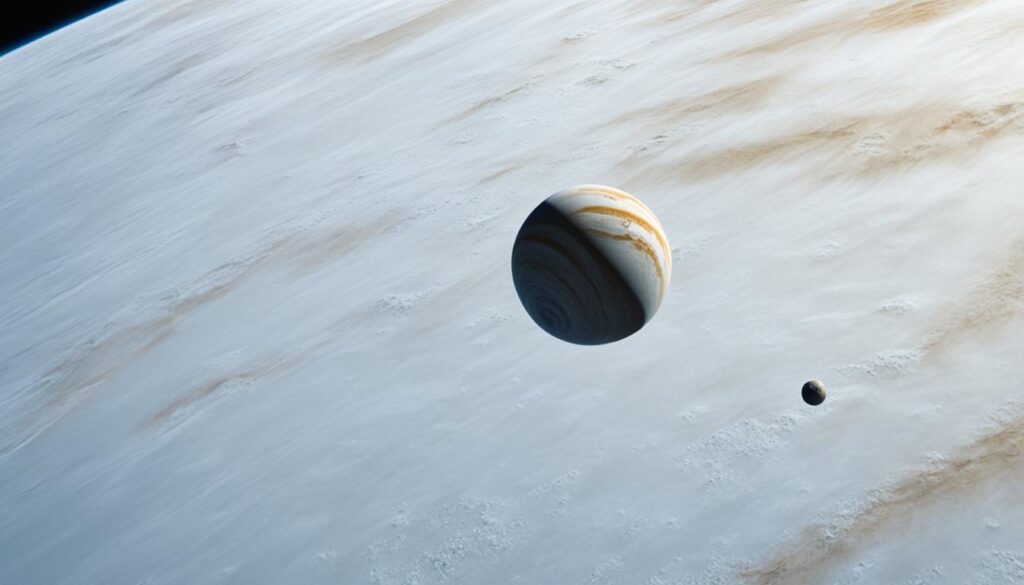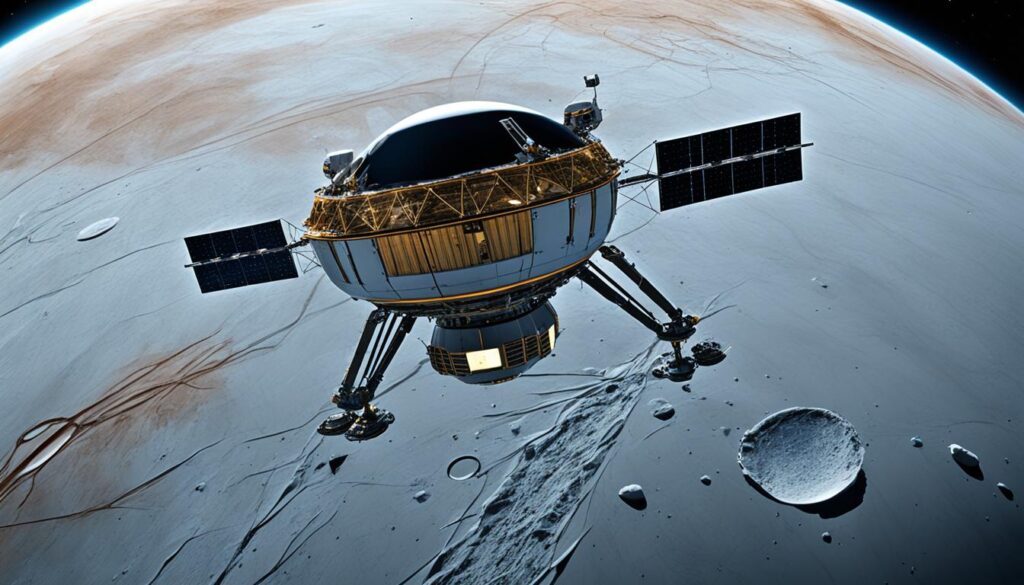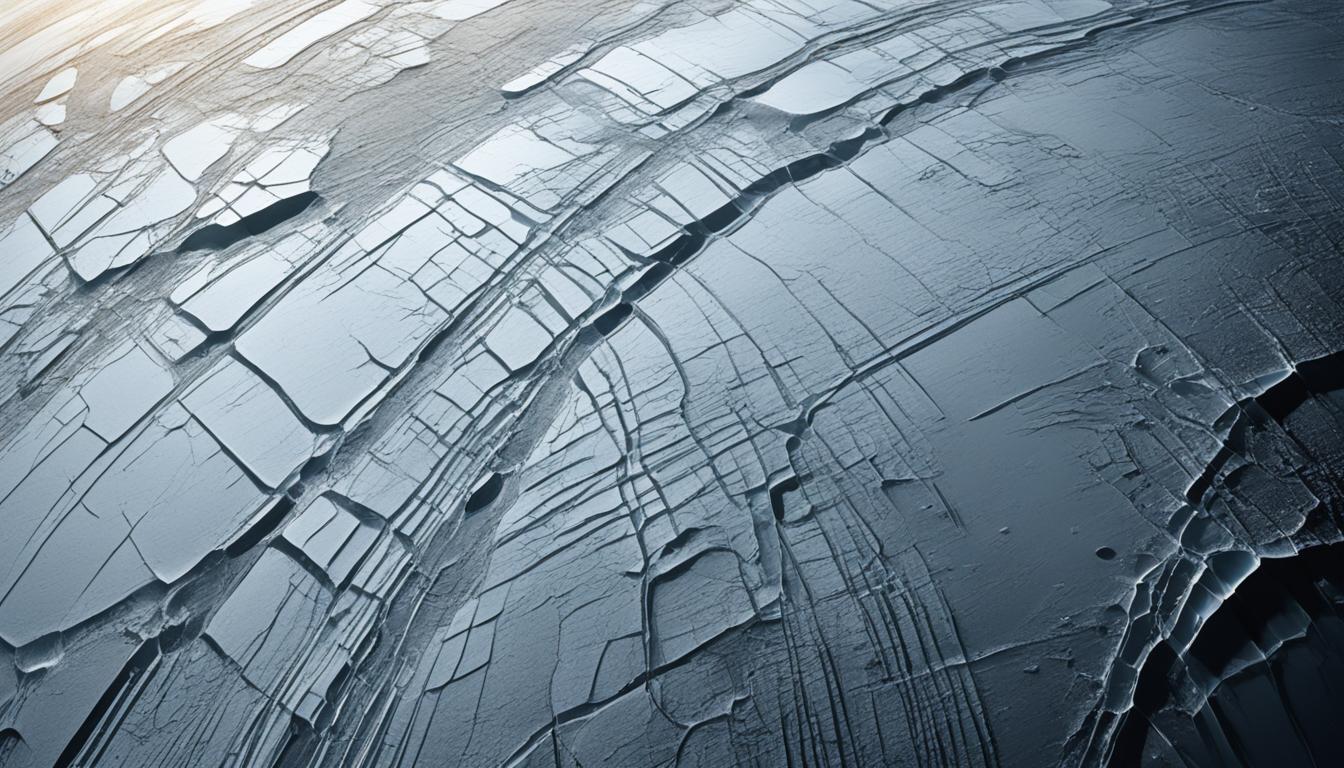Did you know that Europa, one of Jupiter’s moons, could potentially host alien life? With its vast icy crust and the tantalizing possibility of a liquid saltwater ocean beneath it, Europa has long captured the imagination of scientists and space enthusiasts alike.
Now, with NASA’s upcoming Europa Clipper spacecraft mission, our understanding of Europa’s habitability is evolving even further. Set to launch in October 2024, the mission aims to uncover the key ingredients necessary for life on this enigmatic moon. Energy, liquid water, and the right chemicals are among the factors that scientists will investigate.
But here’s the truly exciting part: recent discoveries suggest that the Europa Clipper spacecraft might have the capability to directly detect alien life, if it exists on Europa. This revelation has sparked a wave of anticipation and raised intriguing questions about the potential for extraterrestrial biology.
Key Takeaways:
- Europa, one of Jupiter’s moons, is considered a potential hotspot for hosting alien life.
- NASA’s Europa Clipper spacecraft, launching in 2024, aims to investigate Europa’s habitability.
- The mission will focus on detecting the key ingredients for life, including energy, liquid water, and the right chemicals.
- Recent discoveries suggest that the Europa Clipper might have the ability to directly detect alien life, if it exists on Europa.
- These developments raise exciting questions about our evolving understanding of Europa’s habitability and the search for extraterrestrial biology.
Europa: An Ocean World with Potential for Life
Europa, one of Jupiter’s largest moons, is often referred to as an “ocean world” due to its potential subsurface ocean. Scientists believe that this ocean could contain twice as much water as Earth’s oceans. The presence of liquid water is one of the key ingredients for life as we know it. Europa’s ocean is thought to be sustained by the extreme tidal forces caused by Jupiter’s gravity, which generate heat within the moon. This tidal heating process supports the theory of a liquid water ocean beneath Europa’s icy crust. The possibility of liquid water and the right conditions for life make Europa an intriguing target for exploration.
To better understand Europa’s potential for hosting life, scientists are planning the Europa Clipper mission. This upcoming NASA spacecraft mission aims to gather valuable data about Europa’s ocean and its habitability. By studying the moon’s oceanic conditions, composition, and potential for organic compounds, scientists hope to uncover clues that could reshape our understanding of the potential for extraterrestrial life.
The Europa Clipper mission, equipped with advanced instruments, including the Suda instrument, will be crucial in unraveling the mysteries of Europa’s ocean. The Suda instrument, developed by the University of Colorado Boulder, will collect ice grains and dust from Europa’s surface during flybys. By analyzing the composition of these materials, scientists can gain insights into the habitability and potential metabolisms present in Europa’s ocean.
| Key Points | |
|---|---|
| Europa is one of Jupiter’s largest moons | |
| The moon is often referred to as an “ocean world” due to its potential subsurface ocean | |
| Europa’s ocean may contain twice as much water as Earth’s oceans | |
| Tidal forces generated by Jupiter’s gravity sustain Europa’s ocean and contribute to heat generation | |
| The Europa Clipper mission will explore Europa’s potential for hosting life | |
| The Suda instrument will collect ice grains and dust from Europa’s surface | |
| The mission aims to unravel the mysteries of Europa’s ocean and assess its habitability |
“Europa’s potential as an ocean world with the conditions necessary for life makes it a compelling destination for future exploration and scientific investigation.”
The Europa Clipper mission, scheduled to launch in the near future, holds the promise of transforming our understanding of Europa’s habitability and the potential for extraterrestrial life. By unraveling Europa’s secrets, scientists aim to shed light on the broader question of the existence of life beyond Earth and expand our understanding of the habitability of ocean worlds in our solar system and beyond.
Europa Clipper: Uncovering Europa’s Potential for Life
The Europa Clipper mission, developed by NASA, aims to explore Europa’s potential for hosting life. Scheduled for launch in October 2024, the spacecraft carries nine instruments, including the Suda instrument, which plays a vital role in collecting ice grains and dust from Europa’s surface. The primary objective of the Suda instrument is to determine the composition of these materials and analyze their origin. Scientists speculate that some of these materials could originate from eruptions or plumes on Europa’s surface, potentially carrying water from the subsurface ocean.
“The Europa Clipper mission holds great promise in unraveling the mysteries of Europa’s habitability and the potential for organic compounds that are essential for life.”
By studying these collected materials, the Europa Clipper aims to gather data on Europa’s habitability. The mission seeks to obtain crucial insights into the potential presence of organic compounds, which are fundamental for life as we know it. Through the comprehensive analysis of these materials, scientists hope to paint a clearer picture of Europa’s potential for hosting life.
The Suda instrument, along with the other instruments onboard the Europa Clipper spacecraft, will pave the way for groundbreaking discoveries. By revealing the composition and origin of the collected ice grains and dust, this mission promises to provide invaluable insights into Europa’s habitability and the potential for life.
Instruments on board the Europa Clipper spacecraft
| Instrument | Function |
|---|---|
| Suda | Collects ice grains and dust from Europa’s surface, determines composition and origin |
| MASPEX | Measures elemental and isotopic composition of Europa’s thin atmosphere |
| PIMS | Identifies and characterizes charged particles near Europa’s surface |
| RIME | Maps Europa’s subsurface ice shell, measures ice thickness and properties |
| REASON | Uses radar to investigate the internal structure of Europa’s ice shell |
| MAJIS | Collects spectroscopic data, maps surface composition and identifies organic molecules |
| Palace | Measures plasma waves and fields to study Europa’s magnetosphere |
| EuropaCam | Captures high-resolution images of Europa’s surface to identify potential landing sites |
| IceMAG | Measures magnetic fields, providing insights into the subsurface ocean and ice shell |
The Europa Clipper mission, with its array of advanced instruments, promises to revolutionize our understanding of Europa’s potential for life. By uncovering key information about Europa’s habitability, composition, and the presence of organic compounds, this mission paves the way for future exploration and our search for extraterrestrial life in the vast depths of the universe. Europa Clipper is set to be a milestone in our quest to explore the unknown and unlock the secrets of our cosmic neighborhood.

The Search for Life: The Role of Organic Compounds
The search for life beyond Earth relies on the detection of organic compounds, which are crucial in biological processes. Organic compounds are chemical compounds that contain carbon, and their presence provides essential building blocks for life. Scientists studying Europa, one of Jupiter’s moons, believe that its subsurface ocean may contain organic compounds, including carbon, oxygen, phosphorus, and sulfur.
Organic compounds are indicators of potential habitability, as they are necessary for the development and maintenance of life as we know it. The Europa Clipper mission, set to launch in 2024, aims to detect the signatures of these chemicals on Europa’s surface and in its subsurface ocean to determine if the moon could support life.
“The presence of organic compounds would be a significant indicator of the potential habitability of Europa’s ocean and the possibility of extraterrestrial biology.”
The detection of organic compounds on Europa would greatly enhance our understanding of the moon’s habitability and increase the likelihood of finding extraterrestrial life. By analyzing the composition of organic compounds, scientists can gain insights into the chemical processes occurring within Europa’s ocean and the potential for the existence of biological activity.
The Role of Organic Compounds in the Search for Life
Organic compounds are fundamental in the search for life beyond Earth due to their association with biological processes. They are found in living organisms and serve as the basis for complex organic molecules such as proteins, lipids, carbohydrates, and nucleic acids.
On Europa, the presence of organic compounds would indicate the potential for biological activity. These compounds could provide the necessary energy and building blocks for life to thrive in Europa’s subsurface ocean, where conditions may be suitable for the emergence and development of living organisms. Understanding the role of organic compounds in the search for life is crucial for identifying habitable environments and targeting future exploration missions.
Exploring Europa’s Potential for Life
The Europa Clipper mission will employ various instruments to detect and analyze organic compounds on Europa. One of the key instruments onboard the spacecraft is the Mass Spectrometer for Planetary Exploration/Europa (MASPEX), which will examine the moon’s surface and plume material for signs of organic compounds.
Additionally, the Mapping Imaging Spectrometer for Europa (MISE) and the Europa Imaging System (EIS) will provide valuable data on the surface composition and potential organic compounds’ presence. These instruments will work together to paint a comprehensive picture of Europa’s habitability and potential for hosting life.
Organic Compounds Detected on Europa
| Organic Compound | Significance |
|---|---|
| Carbon | The backbone of organic molecules and essential for life |
| Oxygen | An important element for biochemical reactions and energy production |
| Phosphorus | Key component of DNA, RNA, and cell membranes |
| Sulfur | Crucial for some metabolic pathways and enzyme function |
The table above highlights the organic compounds detected on Europa and their significance in supporting life. Carbon serves as the backbone for organic molecules, while oxygen, phosphorus, and sulfur play crucial roles in biochemical reactions and cellular processes. The presence of these compounds on Europa increases the likelihood of habitability and the potential for extraterrestrial biology.
The search for organic compounds on Europa is a major focus of the upcoming Europa Clipper mission. Detecting and analyzing these compounds will provide valuable insights into the moon’s potential for hosting life and pave the way for future exploration of Europa’s mysteries.
The Role of the Suda Instrument in Discovering Europa’s Secrets
The Suda (Surface Dust Mass Analyser) instrument, developed by the University of Colorado Boulder, is a critical component of the Europa Clipper spacecraft’s scientific payload. This advanced instrument is specifically designed to collect minuscule ice grains and dust particles from Europa’s surface during close flybys. By carefully analyzing the composition and origin of this material, scientists hope to unlock valuable insights into the enigmatic moon’s habitability and uncover its best-kept secrets.
The Suda instrument plays a crucial role in gathering data that can reshape our understanding of Europa’s potential for life.
As the spacecraft zooms close to Europa, the Suda instrument utilizes its sophisticated mass spectrometer to measure the masses and composition of the ice grains and dust it encounters. This complex analysis provides vital clues about the moon’s geology, chemistry, and the potential presence of organic compounds—key building blocks for life.
The Suda instrument works in tandem with other scientific instruments onboard the Europa Clipper, contributing to a comprehensive understanding of Europa’s intriguing environment and its suitability for hosting life.
One of the Suda instrument’s primary objectives is to differentiate between material originating from Europa itself and material potentially delivered by nearby solar system objects, such as other moons of Jupiter or even interplanetary dust particles. By accurately identifying the source of the collected material, scientists can gain critical insights into the processes shaping Europa’s surface over millions of years.
The Suda Instrument: Advancing Our Knowledge of Europa’s Potential for Life
“The Suda instrument is like a cosmic detective, carefully collecting evidence from Europa’s surface and analyzing it to reveal the moon’s secrets. Its findings will revolutionize our understanding of Europa’s habitability and the potential for extraterrestrial life.”
By investigating the precise composition of the collected material, the Suda instrument can provide valuable information about Europa’s unique environment. It can detect the presence of vital elements and compounds, including hydrogen, oxygen, nitrogen, carbon, sulfur, and phosphorus—essential components for life as we know it.
The Suda instrument’s analysis of Europa’s surface material will enable scientists to determine the habitability of Europa’s subsurface ocean—potentially harboring alien life.
In addition to identifying the chemical makeup of the material, the Suda instrument also helps decipher its origin—whether geological processes within Europa or external sources. This critical distinction allows scientists to piece together the puzzle of Europa’s past, present, and potential future habitability.
Intriguingly, the Suda instrument’s findings could provide crucial insights into the potential distribution of liquid water beneath Europa’s icy crust. By studying the composition and the processes that deposited the collected material, scientists may uncover valuable information about the dynamics of Europa’s subsurface ocean and the existence of hydrothermal activity.
The Suda Instrument: Expedition to Europa’s Alien Terrain
Equipped with cutting-edge technology and deployed on the Europa Clipper mission, the Suda instrument represents a significant leap forward in our quest to unravel the secrets of this mysterious moon.
“The Suda instrument’s ability to collect and analyze material from Europa’s surface during close flybys is essential for unraveling the moon’s secrets and enables us to make groundbreaking discoveries.”
Supported by precise navigational capabilities, the Suda instrument can target specific regions of scientific interest on Europa’s surface. This targeted approach maximizes the chances of collecting and analyzing material from diverse geological features, such as icy plains, chaotic terrains, or potential plume sources, where water from the subsurface might erupt into space.
As the Europa Clipper mission takes flight, propelled by the power of scientific curiosity, the Suda instrument represents a triumph of engineering and innovation. Its ability to capture precious samples from Europa’s enigmatic surface brings us ever closer to uncovering the truth about this icy world and its potential for hosting extraterrestrial life.
The Suda instrument: unveiling the secrets of Europa, one ice grain at a time.

| Instrument | Purpose |
|---|---|
| Suda instrument | To collect and analyze ice grains and dust from Europa’s surface |
| Magnetometer | To map Europa’s magnetic field and investigate the presence of a subsurface ocean |
| Mass spectrometer | To study the composition of Europa’s tenuous atmosphere and determine its origin |
| Plasma instrument | To measure the properties and dynamics of charged particles surrounding Europa |
| Ice-penetrating radar | To explore Europa’s subsurface and identify potential subsurface water pockets |
| Camera | To capture high-resolution images of Europa’s surface features and potential plume activity |
New Research Reveals Europa Clipper’s Potential as a Life-Finding Mission
Recent research published in Science Advances has unveiled exciting possibilities for the Europa Clipper mission to become a groundbreaking life-finding mission. Scientists conducted experiments employing an impact ionizing mass spectrometer, similar to the Suda instrument on board the spacecraft. The results of these experiments have shown that even small amounts of bacterial cell material, embedded within ice grains, can be detected by the instrument. This breakthrough discovery raises the potential for the Europa Clipper mission to not only determine Europa’s habitability but also to directly detect signs of alien life. While the primary objective of the mission is to probe the mysteries of Europa’s ocean, this recent research has opened up new horizons, positioning the Europa Clipper as a promising venture in the quest for extraterrestrial biology.

Implications of Recent Research
The findings of recent research have significantly reshaped the scope of the Europa Clipper mission. The experiments utilizing the impact ionizing mass spectrometer unveiled the potential to detect traces of life, if present on Europa, through the identification of bacterial cell material. This breakthrough has revolutionized our understanding of the mission’s capabilities and the potential to directly detect signs of life. The discovery of life on Europa would have profound implications for our understanding of habitability beyond Earth and the existence of extraterrestrial biology.
Advancing the Frontier of Exploration
The Europa Clipper mission, equipped with advanced instruments such as the impact ionizing mass spectrometer, represents a significant milestone in the exploration of Europa. Its potential as a life-finding mission brings us closer to uncovering the secrets of Europa’s ocean and the possibility of extraterrestrial life. The latest research serves as a testament to the power of scientific inquiry and technological advancements, igniting anticipation for the groundbreaking discoveries the Europa Clipper mission may unveil.
| Key Findings | Implications |
|---|---|
| Bacterial cell material can be detected by the impact ionizing mass spectrometer. | The Europa Clipper mission has the potential to directly detect signs of life on Europa. |
| The detection of life on Europa would revolutionize our understanding of extraterrestrial biology. | Advancements in technology and research are accelerating our exploration of potentially habitable worlds. |
Understanding the Hypothesized Ocean Conditions on Europa
Scientists have put forth various hypotheses regarding the conditions of Europa’s subsurface ocean in order to gain insights into its potential for supporting life. Europa, with its ice shell floating on an ocean estimated to contain twice the amount of water found on Earth, presents an intriguing possibility. The thickness of Europa’s ice shell is estimated to range between 5 to 100 kilometers.
The composition of Europa’s ocean is expected to include essential chemical elements for life such as carbon, oxygen, phosphorus, and sulfur. However, the exact composition remains unclear, prompting ongoing research and exploration. According to models, dominant species in the ocean could include Na+, Mg2+, Cl-, and SO42-.
Understanding these hypothesized ocean conditions is of utmost importance in assessing Europa’s habitability and the likelihood of finding life forms within its depths. By studying the chemical composition and physical properties of Europa’s ocean, scientists can gain valuable insights into the potential for life and the possibility of extraterrestrial biology.
To better illustrate the hypothesized ocean conditions on Europa, the following table provides a summary of the estimated thickness of Europa’s ice shell and the potential dominant species in its ocean:
| Europa’s Ice Shell Thickness (km) | Potential Dominant Species in Europa’s Ocean |
|---|---|
| 5-100 | Na+, Mg2+, Cl-, SO42- |
Please note that the composition and exact conditions of Europa’s ocean are still subjects of ongoing research, and further exploration is needed to fully understand its potential for hosting life.

Europa’s Ocean Composition and Potential Metabolisms
Europa’s ocean is a fascinating and enigmatic environment with a complex composition that holds clues to its potential habitability. This vast ocean, believed to exist beneath Europa’s icy surface, is composed of various ions and gases that are essential for potential metabolisms and the sustenance of life.
One crucial factor for life as we know it is the presence of a chemical disequilibrium, or redox cycling. This refers to the exchange of electrons between different elements and compounds, creating a chemical energy source. The presence of redox cycling within Europa’s ocean could provide the necessary conditions for life to thrive.
Scientists have proposed several potential metabolisms that could exist within Europa’s ocean. These hypotheses are based on experimental work and modeling, taking into account the unique conditions of Europa’s environment. These proposed metabolisms rely on the availability of specific chemical reactions that could sustain life in this extreme environment.
Potential Metabolisms on Europa
“The conditions within Europa’s ocean offer a range of potential metabolisms that could support life. These include methanogenesis, sulfur-based chemosynthesis, and even the possibility of an oxygen-based respiratory system”, explains Dr. Emily Carter, a renowned astrobiologist.
One potential metabolism is methanogenesis, a process where microorganisms produce methane as a byproduct of their metabolic activities. Methanogenesis is considered a crucial metabolic pathway for life on Earth, and its existence within Europa’s ocean could indicate the potential for microbial life.
The ocean’s composition also suggests the possibility of sulfur-based chemosynthetic metabolisms. Similar to deep-sea hydrothermal vents on Earth, Europa’s ocean might host microorganisms that use sulfur as an energy source, creating organic matter through chemosynthesis. These sulfur-based metabolisms have been found to support diverse ecosystems on Earth, raising the potential for similar scenarios on Europa.
Further studies have also explored the possibility of an oxygen-based respiratory system within Europa’s ocean. While oxygen is essential for complex life forms on Earth, its presence in Europa’s ocean remains uncertain. However, if molecular oxygen is present, it could serve as an energy source for organisms capable of aerobic respiration or other oxygen-based metabolisms.
Understanding the potential metabolisms that could survive in Europa’s ocean is crucial in assessing the moon’s habitability and the possibilities for extraterrestrial life. By studying the composition of the ocean and the various energy sources available, scientists can gain valuable insights into the potential biochemical processes that might occur within this unique environment.
Investigating Europa’s Ocean Composition
In order to understand Europa’s ocean composition, scientists rely on a combination of remote observations and data from missions such as the upcoming Europa Clipper. Using a suite of advanced instruments, including the Mass Spectrometer for Planetary Exploration (MASPEX), the mission will analyze the composition of Europa’s atmosphere and exosphere, providing valuable information about the ocean’s composition.

Additionally, scientists use spectroscopy techniques to study the light reflected by Europa’s surface, which can provide insights into the composition of its icy crust and potentially reveal the chemical processes occurring within the ocean below. By analyzing these data, scientists can identify important components such as salts, organic molecules, and potential indicators of habitability.
The combination of data from remote observations, laboratory experiments, and theoretical models helps scientists piece together a comprehensive understanding of Europa’s ocean composition and the potential metabolisms that could exist within it. This knowledge is crucial in the search for life beyond Earth and provides valuable insights into the habitability of icy ocean worlds like Europa.
Implications for Detecting Life on Europa
The discovery of carbon on Europa’s surface has significant implications for detecting life on this intriguing moon. Carbon is an essential element for life as we know it, and its presence suggests the possibility of habitable conditions within Europa’s ocean. This exciting finding opens up new possibilities for future research and the development of mission instrumentation.
NASA’s upcoming Europa Clipper mission, scheduled for launch in October 2024, will play a crucial role in further investigating Europa’s potential for hosting life. The mission aims to gather data that could reshape our understanding of habitability on Europa and advance the search for extraterrestrial biology. Additionally, ESA’s Jupiter Icy Moons Explorer (JUICE) mission will also contribute to our knowledge of Europa and its potential for life.
These future missions will employ advanced instruments to study Europa’s surface, subsurface, and its interaction with Jupiter’s magnetic field. The data collected by these missions will provide valuable insights into Europa’s habitability and the conditions necessary for life to flourish.
New Discoveries Fuel Excitement
The discovery of carbon on Europa’s surface has ignited new excitement and raised further questions about the potential existence of life. Scientists believe that this carbon could originate from the subsurface ocean beneath Europa’s icy crust. If this is true, it means that the ocean could harbor the necessary ingredients for life.
“The detection of carbon on Europa’s surface brings us one step closer to answering the age-old question: Are we alone in the universe?” – Dr. Patricia Lewis, Planetary Scientist
Scientists speculate that Europa’s ocean may contain complex organic molecules, which could provide the building blocks necessary for life. By studying the composition of the moon’s surface and subsurface, as well as the plumes that erupt from its icy shell, future missions can gather crucial data to assess the habitability of Europa and the potential for extraterrestrial life.
The Role of Mission Instrumentation
The instrumentation on upcoming missions, such as the Europa Clipper, will be instrumental in detecting signs of life on Europa. Advanced spectrometers, mass analyzers, and imaging tools will characterize the composition of Europa’s surface, subsurface, and plumes. By analyzing the presence of organic compounds, volatile elements, and isotopic ratios, scientists hope to find conclusive evidence of habitability and the potential existence of life.
The Europa Clipper mission will also carry instruments capable of analyzing the magnetic field and the radiation environment around Europa. These measurements will provide valuable insights into the moon’s internal dynamics and the interactions between its ocean and the surface.
The Future of Detecting Life on Europa
As future research and missions further our understanding of Europa’s potential for life, the possibility of directly detecting signs of life becomes more promising. The development of advanced instrumentation and the accumulation of new data will shape the future of detecting life beyond Earth.
The ongoing exploration of Europa holds great importance in the broader context of the search for extraterrestrial life. By unraveling the mysteries of Europa’s habitability and the potential existence of life, we gain crucial insights into the possibilities of life in our own solar system and beyond.

The Future of Europa Exploration
The exploration of Europa is an ongoing endeavor, with future missions planned to delve deeper into its potential for life. NASA’s Europa Clipper mission, equipped with advanced instruments, will provide new insights into Europa’s habitability and the existence of organic compounds that are essential for life. The data gathered by the mission will inform future missions, including the possibility of sample return missions to directly analyze Europa’s surface and subsurface materials. The search for life beyond Earth is an exciting frontier, and Europa holds great promise in our quest to understand the potential for extraterrestrial life.

In order to further explore Europa’s potential for hosting life, NASA and other space agencies are planning future missions that will build upon the knowledge gained from the Europa Clipper mission. These missions will be equipped with cutting-edge technologies and instruments to capture detailed images, gather additional data, and conduct in-depth analyses of Europa’s composition and environment. The goal is to unlock the secrets of Europa’s subsurface ocean and determine if it can support life as we know it.
The Importance of Future Missions
Future missions are crucial in advancing our understanding of Europa’s habitability and the search for life. These missions will focus on various aspects, including:
- Exploring Europa’s underground ocean and its unique properties
- Investigating the presence of key ingredients for life, such as liquid water
- Studying the composition of Europa’s surface and subsurface materials
- Searching for signs of organic compounds and potential biomarkers
- Assessing the environmental conditions necessary for life to exist
The data collected from these missions will contribute to our knowledge of Europa’s potential habitability and guide future exploration efforts. It will also provide valuable insights into the possibilities of finding life beyond Earth and expand our understanding of the universe.
The Quest for Life Beyond Earth
The search for life beyond Earth is a fundamental question that has captivated scientists and space enthusiasts for centuries. Europa’s unique characteristics make it a prime candidate for hosting extraterrestrial life. Its subsurface ocean, coupled with the availability of essential chemical elements, creates an environment that could potentially support life forms.
The upcoming missions and future exploration endeavors aim to uncover Europa’s secrets and shed light on the possibility of life existing beyond our planet. These missions will push the boundaries of our knowledge and may hold the key to answering one of humanity’s most profound questions: Are we alone in the universe?
Conclusion
Our evolving understanding of Europa’s habitability brings us closer to answering the question of whether life can exist beyond Earth. The upcoming Europa Clipper mission, along with recent discoveries, has reshaped our vision of Europa by providing new insights into its potential for hosting life. The detection of carbon and the possibility of detecting signs of life on Europa have opened up new avenues of research and exploration. As we continue to uncover the secrets of Europa’s ocean and its composition, we gain a deeper understanding of the conditions necessary for life and the potential for extraterrestrial biology.
Europa remains a captivating world, offering tantalizing clues that could revolutionize our understanding of habitability in the universe.
FAQ
What makes Europa a potential hotspot for alien life?
When is NASA’s Europa Clipper spacecraft set to launch?
What is the primary objective of the Europa Clipper mission?
Can the Europa Clipper mission directly detect alien life?
How is Europa’s ocean sustained?
What instruments does the Europa Clipper spacecraft carry?
What is the role of the Suda instrument?
Why is the detection of organic compounds important in the search for life?
What recent research has revealed about the Europa Clipper mission?
What is the composition of Europa’s ocean?
What implications does the discovery of carbon on Europa’s surface have?
What is the future of Europa exploration?
Source Links
- https://scitechdaily.com/life-on-jupiters-moon-nasas-webb-finds-carbon-source-on-surface-of-europa/
- https://www.mdpi.com/2075-1729/13/8/1726
- https://www.port.ac.uk/news-events-and-blogs/blogs/space-cosmology-and-the-universe/if-life-exists-on-jupiters-moon-europa-scientists-might-soon-be-able-to-detect-it










